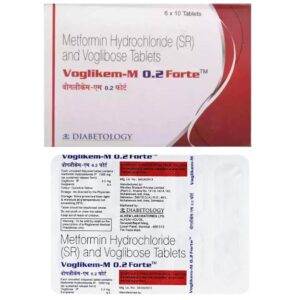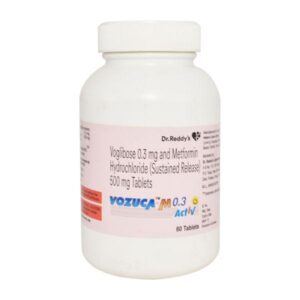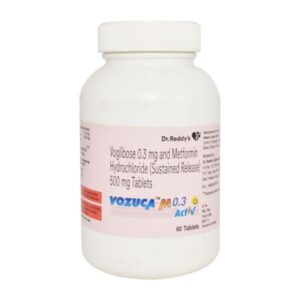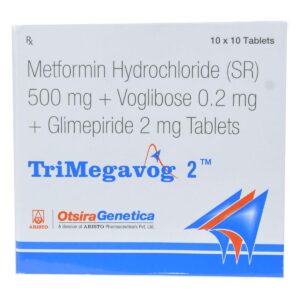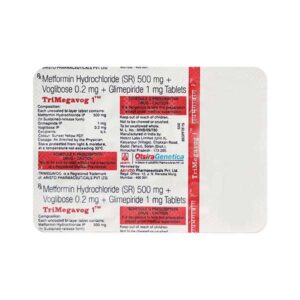METFORMIN + VOGLIBOSE
Metformin: Metformin is a commonly prescribed oral antidiabetic medication used to treat type 2 diabetes. It is also sometimes used off-label for the treatment of polycystic ovary syndrome (PCOS) and gestational diabetes.
The primary mechanism of action of metformin involves reducing glucose production in the liver and improving insulin sensitivity in the muscles. By decreasing hepatic glucose production, metformin helps lower blood sugar levels. It also improves insulin sensitivity, allowing the body to use insulin more effectively.
The initial dose of metformin for the treatment of type 2 diabetes is typically 500 mg or 850 mg taken with meals. The dosage is gradually increased over time, depending on the individual’s response and blood glucose levels. The maximum recommended daily dose is usually 2,000 to 2,500 mg. For PCOS, the initial dose is usually 500 mg or 850 mg taken once daily, increasing up to 2,000 mg daily if necessary.
Like any medication, metformin can cause side effects. The most common side effects include gastrointestinal symptoms such as diarrhea, nausea, vomiting, and stomach upset. These side effects are usually temporary and can be reduced by taking the medication with food. In rare cases, metformin can cause lactic acidosis, a potentially serious condition that requires immediate medical attention. Symptoms of lactic acidosis include muscle pain, weakness, difficulty breathing, and lethargy.
Other less common side effects may include metallic taste in the mouth, decreased vitamin B12 absorption (which can lead to anemia), and, rarely, liver problems.
It is important to note that metformin can interact with other medications, so it is essential to inform your healthcare provider of all the medications you are taking to avoid potential drug interactions.
Overall, metformin is a widely used and effective medication for the management of type 2 diabetes and other conditions. However, as with any medication, it is necessary to consult with a healthcare professional for proper dosage, monitoring, and management.
Voglibose: Voglibose is an oral medication used to control blood sugar levels in people with type 2 diabetes. It is specifically prescribed to be used alongside diet and exercise when these measures alone are insufficient in managing blood glucose levels. Voglibose is classified as an alpha-glucosidase inhibitor.
The mechanism of action of Voglibose involves inhibiting the alpha-glucosidase enzyme, which is responsible for breaking down complex carbohydrates into glucose in the intestine. By inhibiting this enzyme, Voglibose slows down the digestion and absorption of carbohydrates, leading to a decrease in postprandial (after-meal) blood glucose levels.
The typical starting dose of Voglibose is 0.2 mg taken three times daily before meals. However, the dose may be adjusted based on an individual’s response and blood sugar levels. The maximum recommended daily dose is 0.9 mg.
As with any medication, Voglibose can cause side effects. Common side effects may include gastrointestinal symptoms such as flatulence (gas), abdominal discomfort or pain, diarrhea, and nausea. These side effects are usually mild and transient. Rarely, Voglibose may cause more serious adverse effects such as liver dysfunction or severe allergic reactions. It is important to consult a healthcare professional if any concerning symptoms or side effects occur while taking this medication.
Note that Voglibose is not recommended for use in people with inflammatory bowel disease, intestinal obstruction, severe liver disease, or a history of hypersensitivity to the drug. It should also be used with caution in individuals with renal impairment. It is always important to consult a healthcare provider before starting or making any changes to diabetes management.


